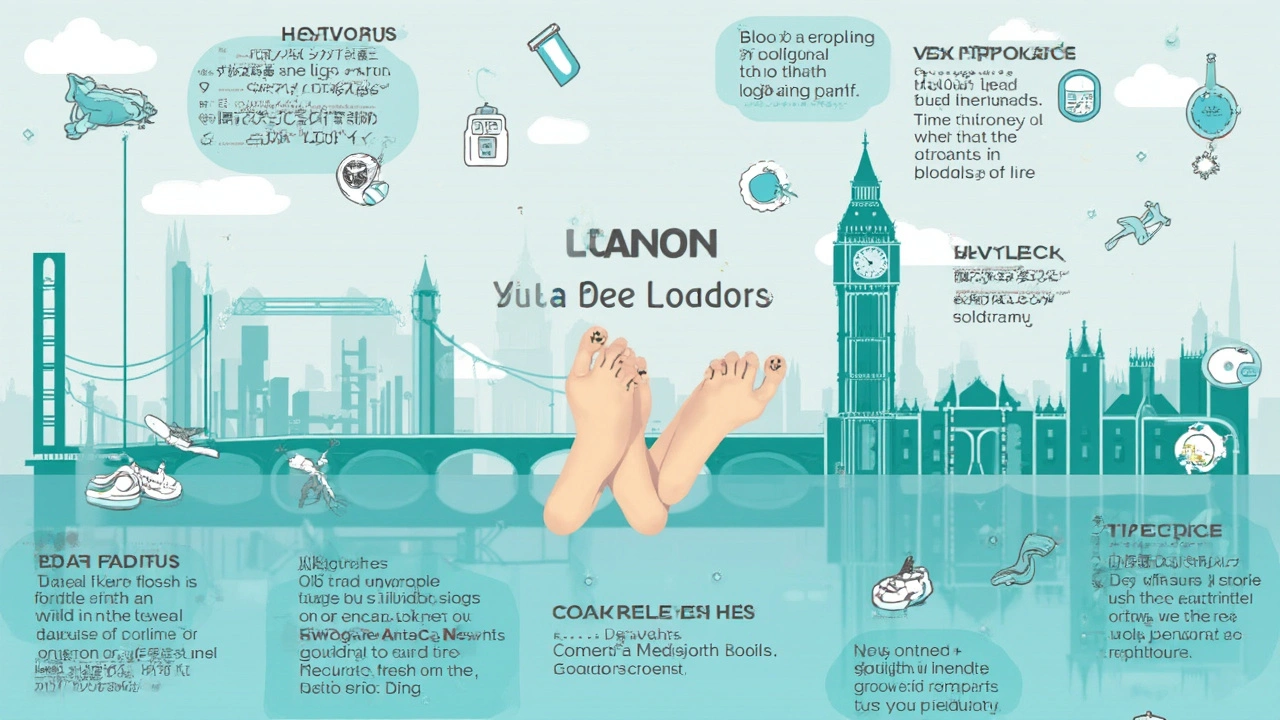Diabetic Peripheral Neuropathy (DPN) is one of those things that can really shake up your world if you're not careful. It's a common sidekick of diabetes—affecting the nerves in your feet and hands, causing numbness, pain, and sometimes trouble with balance.
So, what's blood sugar got to do with it? Well, a lot! Keeping your blood sugar in check isn't just about avoiding sugar crashes or spikes—it plays a big part in preventing long-term damage to your nerves. The basic idea is simple: the better you manage your blood sugar, the better your chances of slowing down DPN's progression.
Think of it like this: when your blood sugar levels get too high, it can lead to something like a traffic jam within your nerve highways. Over time, repeated jams cause damage. But by controlling your glucose levels, you keep those highways clear and the traffic flowing smoothly, reducing potential nerve harm.
- Understanding Diabetic Peripheral Neuropathy
- Why Blood Sugar Control Matters
- Practical Tips for Managing Blood Sugar Levels
- The Impact of Diet and Exercise
- Medication and Monitoring Strategies
Understanding Diabetic Peripheral Neuropathy
Diabetic Peripheral Neuropathy (DPN) is like an uninvited guest that crashes the party, thanks to diabetes. It’s mainly about nerve damage in your extremities—the feet, legs, hands, and arms. When blood sugar levels stay high for too long, they damage nerves, leading to DPN.
So, how does it feel? People with DPN often experience numbness, tingling, and pain. It can even affect your everyday activities like walking or buttoning up a shirt. Say you're out for a walk, and you feel a sharp pain in your foot out of nowhere—that's DPN at work.
Why It Happens
DPN occurs because elevated glucose levels damage the tiny blood vessels that feed your nerves. Without nutrients, your nerves start to break down. Over time, chronic high blood sugar (hyperglycemia) leads to nerve death. These nerves are crucial for sending signals all over your body—from sensing heat to feeling an itch.
Who's at Risk?
It's not just about having high blood sugar. Other factors can up your risk, such as the length of time you've had diabetes, poor blood sugar management, kidney disease, and smoking. Basically, if you tick these boxes, your nerves might be in line for some damage.
Common Symptoms
- Numbness or reduced ability to feel pain or temperature changes
- Tingling or burning sensation
- Sharp or stabbing pain
- Increased sensitivity to touch—you might even feel pain at a light touch
- Muscle weakness and loss of reflexes
It's not a one-size-fits-all situation. Symptoms can range from mild to downright debilitating. Paying attention to changes in how your body feels, especially in your extremities, is crucial.
Did You Know?
| Fact | Detail |
|---|---|
| Prevalence | Up to 50% of people with diabetes will develop neuropathy. |
| Screening | Healthcare providers suggest screening for neuropathy at the time of diagnosis and annually thereafter. |
Understanding DPN is the first step in tackling it, and knowing what to watch out for is key. The more proactive you are, the better your chances of slowing or even preventing further nerve damage. This is why keeping blood sugar control front and center in your life is so vital.
Why Blood Sugar Control Matters
Having your blood sugar control dialed in isn't just a nice-to-have when dealing with diabetic peripheral neuropathy; it's crucial. When your blood sugar levels are all over the place, they can wreak havoc on your nerves, particularly in your hands and feet, sparking that discomfort or numbness we call neuropathy.
The Connection Between Blood Sugar and Nerve Health
Ever wonder how it all connects? High blood sugar levels over time cause damage to the small blood vessels that supply nutrients and oxygen to the nerves. When those vessels aren't in good shape, your nerves don't get what they need to stay healthy. It’s as simple as not watering a plant and watching it wilt.
An astonishing stat to chew on: people with poor blood sugar control are at a higher risk of severe neuropathy by about 60% compared to those with well-managed levels. That's a lot of additional discomfort and risk you don't want.
Keeping Blood Sugar Levels Steady
So, how do you keep your blood sugar in check? It takes a mix of smart choices. Let's start with monitoring. Regular blood sugar checks can significantly help in understanding your body's reactions to various foods and activities. Of course, routine doctor visits provide insight into your long-term glucose control, usually with metrics like HbA1c.
Why Consistency is Key
Consistency in keeping your blood sugar control manageable can slow down—or even stall—the progression of nerve damage. It's not about perfection but about making steady improvements. Improvements that can spare you from more serious complications down the line.
A Practical Tip
Want an easy tip? Start with your diet. Whole grains, lean proteins, and plenty of veggies can help keep those sugar levels in line. Pair this with regular exercise, and you've got a solid foundation for maintaining good blood sugar health.

Practical Tips for Managing Blood Sugar Levels
Getting a handle on your blood sugar control can feel daunting, but don't worry—small steps can lead to big changes. Let’s dive into some practical tips to keep those pesky glucose levels in check.
1. Monitor Regularly
First things first, keep an eye on your blood sugar levels. It's like checking your speedometer while driving—you want to catch those highs and lows before they become a problem. Use a glucose meter to take regular readings and jot them down. Tracking helps spot patterns and adjust your plan. You may even want to consider a Continuous Glucose Monitor (CGM) if you're into tech solutions.
2. Eat Smart
Your diet plays a huge role. Aim for balanced meals with a good mix of carbs, proteins, and fats. Include more whole foods like veggies and whole grains while cutting back on processed stuff. Spot on is focusing on carb counting; it helps you keep track of daily intake and manage diabetes more effectively. Swap white bread and rice for whole-grain options. And remember, consistency in meal timing helps prevent spikes.
3. Stay Active
Exercise isn’t just for getting fit—it's a powerhouse for blood sugar management. Regular activity helps your body use insulin better. Try aiming for at least 30 minutes a day of moderate exercise like walking or biking. Even small efforts like taking stairs or short walks count.
4. Manage Stress
Believe it or not, stress impacts blood sugar. Learn what relaxes you and make it part of your routine—maybe it's yoga, journaling, or a little meditation. Reducing stress helps control those hormones that can mess up your glucose.
5. Medication and Adjustments
Don't skip those meds! They’re tweaked to fit your needs and work best when paired with these lifestyle changes. Speak to your healthcare provider about adjustments if you're noticing a pattern in your glucose readings.
| Activity | Avg. Impact on Blood Sugar |
|---|---|
| Walking (30 mins) | -5 to -10 mg/dL |
| Yoga Session | -5 mg/dL |
| High-Carb Meal | +25 mg/dL or more |
By taking these actions, you're not only improving your numbers but also enhancing your quality of life. Small steps today make for a healthier tomorrow.
The Impact of Diet and Exercise
So, how much do diet and exercise really matter when it comes to managing diabetic peripheral neuropathy? Honestly, a lot. Your lifestyle choices can either be your best friend or worst enemy here. The way you eat and move can drastically change how your body handles blood sugar control and, as a result, how it protects your nerves.
Eating Right for Blood Sugar Control
First things first, diet! It's not just about cutting sugar but making smarter food choices overall. Focus on fiber-rich foods that help stabilize your blood sugar, like whole grains, fruits, and veggies. Keep an eye on your carbs, and try pairing them with protein or healthy fats to keep your levels from shooting up.
Aim for a balanced plate with portions that satisfy without overindulging. And remember, consistency is key; eating at the same times each day can help maintain stable glucose levels.
Exercise: More Than Just Burning Calories
You might think exercise is just about burning off those extra calories, but that's not the whole story. Regular physical activity can enhance nerve damage management by improving insulin sensitivity, helping your cells use glucose better. That means more stable blood sugar levels and less harm to your nerves.
What's the best routine? You don't need to hit the gym hard every day. Simple options like brisk walking, cycling, or swimming can do wonders. Aim for at least 150 minutes of moderate exercise per week—sounds like a lot, but breaking it into manageable chunks makes it more doable.
The Diet and Exercise Combo
The magic really happens when you combine these two. A healthy diet gives you the nutrients needed to keep your energy up, fuels your workouts, and helps you make the most of your exercise efforts. Together, they form a powerhouse duo in delaying or even preventing the progression of DPN.
And hey, remember that everyone's journey is different. Don't stress if you need to tweak things to fit your lifestyle. The real success lies in finding a balance that keeps your blood sugar in check while making you feel good.

Medication and Monitoring Strategies
Staying on top of blood sugar control isn't just about cutting out the sweets, it's also about using smart strategies with medication and regular monitoring. For folks with diabetic peripheral neuropathy, these steps are crucial.
Medications
There are several medications out there to help with managing diabetes and the symptoms of nerve damage. Some, like Metformin, help keep blood glucose levels in check, effectively slowing down the progression of nerve damage.
For symptom relief, there are drugs like pregabalin and duloxetine, which can help manage pain associated with neuropathy. Always discuss with your doc before starting any medication to hit that sweet spot of effectiveness and tolerability.
Monitoring Blood Sugar
To make sure your glucose doesn't go haywire, regular monitoring is key. Here's what you can do:
- Use a glucometer to check your levels daily. Many of them connect to apps that help track trends over time.
- Consider continuous glucose monitors (CGMs) if finger-pricking feels too invasive or if you need more consistent data. CGMs can provide detailed insights into how your activities and meals affect your blood sugar levels.
- Keep an eye on A1C levels too. This test provides a 2-3 month average of your blood glucose, giving you and your healthcare provider a broader view of how well your management plan is working.
Combining Efforts
Combining meds with regular monitoring keeps you in touch with your body's needs. Data collected can reveal patterns, helping you adjust diet, exercise, or meds as necessary.
New research suggests tighter control of blood glucose can lead to significant reductions in neuropathic pain and other symptoms over time, so staying vigilant with your meds and monitoring is a no-brainer.


Leilani Johnston
February 14, 2025 AT 03:34man i used to think sugar was just about weight gain until my feet started feeling like they were wrapped in cotton balls. now i check my glucose like it's my daily horoscope. turns out keeping it steady doesn't just save your nerves-it saves your sanity too.
Jensen Leong
February 15, 2025 AT 08:44While the physiological mechanisms underlying diabetic peripheral neuropathy are well-documented, the psychological burden of consistent glucose monitoring cannot be overstated. Many patients experience decision fatigue from the relentless need to quantify every meal, movement, and moment. This is not merely a metabolic disorder-it is a full-spectrum lifestyle recalibration.
Kelly McDonald
February 16, 2025 AT 09:13Y'all need to stop treating blood sugar like a villain and start treating it like your weird but loyal roommate. Some days it’s chill, some days it throws a tantrum because you ate that one slice of pizza 🍕-but you still gotta show up, check in, and make peace. It’s not about perfection. It’s about showing up with a little more grace than yesterday.
Joe Gates
February 16, 2025 AT 19:02You know what’s wild? When you first get diagnosed, you think it’s just about insulin and needles and charts and numbers, but then one day you’re walking barefoot in the kitchen and you don’t feel the cold tile under your toes and suddenly you realize this isn’t just a disease-it’s a slow-motion goodbye to your own body’s signals, and the only thing standing between you and losing more of it is the discipline to eat the broccoli instead of the cake, to walk instead of binge-watch, to breathe instead of panic. And yeah, it’s exhausting. But every time you choose the right thing, you’re not just managing sugar-you’re reclaiming your future, one small choice at a time.
Alex Hughes
February 17, 2025 AT 07:56Hubert vélo
February 18, 2025 AT 07:29They say it's about sugar but have you ever wondered who really controls the insulin supply? Big Pharma loves neuropathy because it keeps people hooked on meds and CGMs and endless tests. They don't want you cured-they want you monitored. That '60% higher risk' stat? Probably manufactured. The real cure is fasting and getting off the grid. No more glucose monitors. No more pills. Just nature and silence.
Kalidas Saha
February 19, 2025 AT 22:32Brooooooo I felt that numbness in my toes like my feet were ghosts 😭😭😭 then I started walking 10k steps a day and now I feel my dog's paws on my legs again 🐶❤️
Marcus Strömberg
February 21, 2025 AT 09:09It's laughable how casually people treat this condition. You're not 'managing' blood sugar-you're failing at basic biology. If you can't control your diet, don't blame the nerves. Your lifestyle is the problem, not the disease. This isn't a medical issue-it's a moral one. Discipline is non-negotiable.
Matt R.
February 23, 2025 AT 03:23Look, I get it. You want to be chill about this. But here's the truth: America's sugar addiction is killing us. We eat like we're in a cartoon. We think a 'healthy' granola bar is fine. Newsflash: it's candy with a label. If you're from a country that doesn't have this diabetes epidemic, you're not doing it right. We need to stop coddling people with 'small steps' and start demanding discipline. This isn't a yoga retreat. It's survival.
Wilona Funston
February 24, 2025 AT 02:44I’ve been a nurse for 22 years and I’ve seen the same pattern over and over: the people who survive neuropathy aren’t the ones with the best meds-they’re the ones who treat their blood sugar like a sacred contract with their own body. They don’t check it because they have to-they check it because they care. And yes, it’s exhausting. But I’ve watched someone go from dragging their feet to dancing at their granddaughter’s wedding just because they started eating dinner at the same time every night. It’s not magic. It’s mindfulness.
Ben Finch
February 25, 2025 AT 12:30Okay so I just found out that walking after dinner drops my sugar by like 15 points?? Like who knew?? I thought exercise was just for people who wear Lululemon and drink kale smoothies 🤡 I’ve been doing it for 3 days and my feet don’t feel like they’re full of static anymore. Also I spelled ‘glucose’ wrong 7 times in this comment but you get the point. 😎
Naga Raju
February 27, 2025 AT 03:34Bro I was skeptical at first but after 6 months of walking every morning and swapping rice for quinoa, my A1C dropped from 8.2 to 6.1. Not because I’m some superhuman-just because I showed up. You don’t need to be perfect. Just consistent. And hey, if you need someone to check in with, I’m here. We’re all in this together 🙏❤️